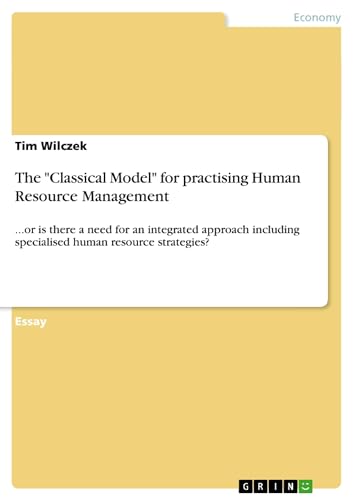The "Classical Model" for practising Human Resource Management: ...or is there a need for an integrated approach including specialised human resource strategies? - Softcover

"synopsis" may belong to another edition of this title.
- PublisherGRIN Verlag
- Publication date2008
- ISBN 10 3640173708
- ISBN 13 9783640173709
- BindingPaperback
- Number of pages40
Buy New
Learn more about this copy
Shipping:
US$ 24.50
From Germany to U.S.A.
Top Search Results from the AbeBooks Marketplace
The "Classical Model" for practising Human Resource Management
Book Description Taschenbuch. Condition: Neu. This item is printed on demand - it takes 3-4 days longer - Neuware -Essay from the year 2008 in the subject Leadership and Human Resource Management - Miscellaneous, grade: 2,3, University of Western Sydney (School of Management), course: Human Resource Strategy, language: English, abstract: During recent years an efficient Human Resource Management (HRM) hasbecome more and more important for companies to achieve and sustain bothcompetitiveness and economic success. Leopold, Harris and Watson (2005)mentioned that Human Resources became matters of considerable competitiveadvantage. Human Resources, respectively the skills and knowledge of anorganisation's staff, as Hamel and Prahalat (1994) called it, has transformedthrough massive changes in the economical, technological, sociocultural,judicial and political conditions to one of the most important strategic factor ofsuccess for companies these days. HRM, as a reaction to these changes in'Personnel Management', attempts to find various methods of resolution forpractice. If 'Personnel Management', 'HRM' or 'SHRM', they all have a commongoal: obtaining the achievement potential of all organisational members best aspossible. But the 'HRM' approach goes beyond the traditional approach of'Personnel Management', having a broader focus on the necessaryinterdependence of all components with each other as well as the connection toother compartments of companies, whose success is seen in straightconnection with personnel measures.Thereby Strategic Human Resource Management (SHRM) can be seen asextension of HRM, and following the definition of Boxall (1996) it deals with therelationship between the strategic management of an organisation and themanagement of its human resources within this strategic context. In that casethe focus is on long-term personnel decisions as well as on the question how aninteraction of corporate and personnel strategy can be achieved.Initially this work is going to introduce and define different organizationalstrategies as well as key human resource strategies. This shall be followed by acritical evaluation of the concepts by opposing the pros to the cons. Therein thedifficulties and between Organisational Strategy, Human Resource Strategy andthe Organizational Environment shall be shown. The work results in a finalconclusion. 20 pp. Englisch. Seller Inventory # 9783640173709
The "Classical Model" for practising Human Resource Management : .or is there a need for an integrated approach including specialised human resource strategies?
Book Description Taschenbuch. Condition: Neu. Druck auf Anfrage Neuware - Printed after ordering - Essay from the year 2008 in the subject Leadership and Human Resource Management - Miscellaneous, grade: 2,3, University of Western Sydney (School of Management), course: Human Resource Strategy, language: English, abstract: During recent years an efficient Human Resource Management (HRM) hasbecome more and more important for companies to achieve and sustain bothcompetitiveness and economic success. Leopold, Harris and Watson (2005)mentioned that Human Resources became matters of considerable competitiveadvantage. Human Resources, respectively the skills and knowledge of anorganisation's staff, as Hamel and Prahalat (1994) called it, has transformedthrough massive changes in the economical, technological, sociocultural,judicial and political conditions to one of the most important strategic factor ofsuccess for companies these days. HRM, as a reaction to these changes in'Personnel Management', attempts to find various methods of resolution forpractice. If 'Personnel Management', 'HRM' or 'SHRM', they all have a commongoal: obtaining the achievement potential of all organisational members best aspossible. But the 'HRM' approach goes beyond the traditional approach of'Personnel Management', having a broader focus on the necessaryinterdependence of all components with each other as well as the connection toother compartments of companies, whose success is seen in straightconnection with personnel measures.Thereby Strategic Human Resource Management (SHRM) can be seen asextension of HRM, and following the definition of Boxall (1996) it deals with therelationship between the strategic management of an organisation and themanagement of its human resources within this strategic context. In that casethe focus is on long-term personnel decisions as well as on the question how aninteraction of corporate and personnel strategy can be achieved.Initially this work is going to introduce and define different organizationalstrategies as well as key human resource strategies. This shall be followed by acritical evaluation of the concepts by opposing the pros to the cons. Therein thedifficulties and between Organisational Strategy, Human Resource Strategy andthe Organizational Environment shall be shown. The work results in a finalconclusion. Seller Inventory # 9783640173709

